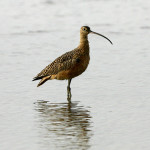• • •
The long searching bills of the shorebirds reach their zenith in the Long-billed Curlew. With a head and ridiculous downcurved bill about the same length as the rest of its body, it can reach crabs and shrimp buried deep in the sand and mud.
• Length: 23 inches
• Wingspan: 35 inches
• Season: Winter
More about Long-billed Curlews.
Where they are, and when.
Long-billed Curlews spend summers in the fields and prairies of western North America as far south as the Panhandle before migrating to the West and Gulf coasts and Mexico, where they frequent wetlands, bays, mudflats and beaches, often congregating in small groups. Arrivals on the Gulf Coast begin as early as July and their spring departure begins as early as February.
They walk steadily as they forage, picking at the ground or digging more deeply with their bills. In addition to crabs and shrimp they will eat insects, mollusks, worms and other marine invertebrates.





